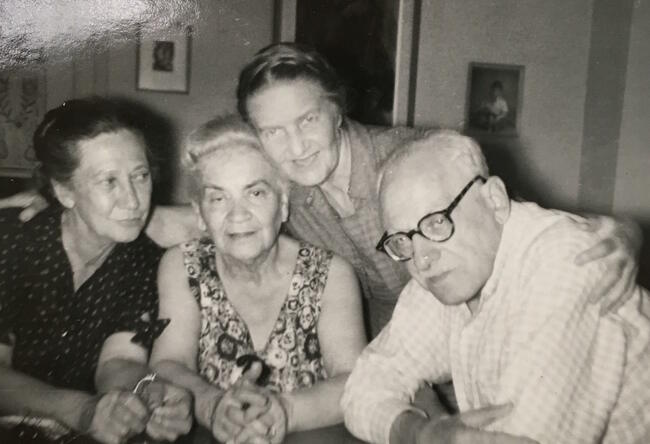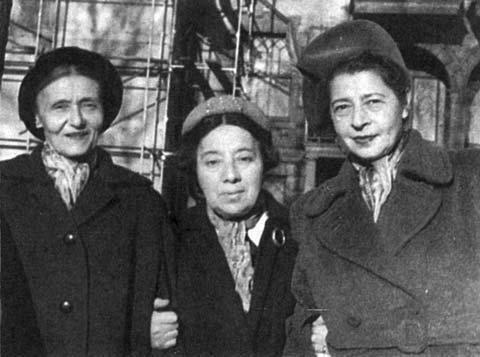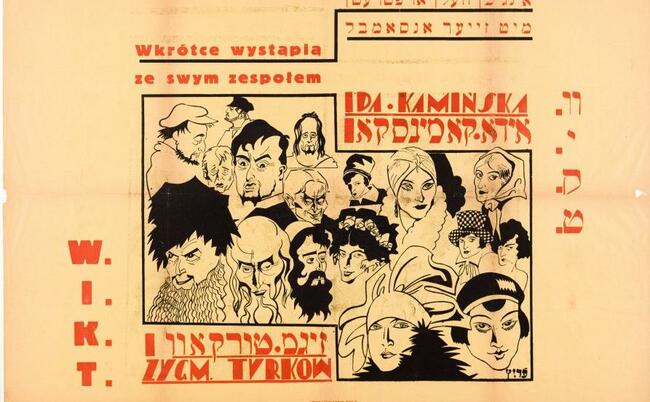Molodowsky’s Embrace
“In their salons, women held court and claimed a space for themselves at the center of literary life.”
Among hundreds of items in the Bertha Kling archive at the YIVO Institute in New York, one small Kodak print caught our eye. A black and white snapshot, with a handwritten date on the back—July 8, 1959—it shows Bertha and Yekhiel Kling with two other women. They are not identified, but one of them looked familiar. She smiles brightly into the camera, her gaze intense, her thick hair parted in the center. It took a while, but eventually we put a name to the face: Kadya Molodowsky, one of the most renowned Yiddish writers of the twentieth century. At that point we reached out to Faith Jones and Hanna Kipnis King, whose feminist reading group has been studying Molodowsky's autobiography. We are grateful to them for so readily agreeing to take the 1959 snapshot as a starting point to explore some broader questions: What was the connection between Molodowsky and Bertha Kling? What is revealed in this moment of intimacy? And what—in terms of the role of these writers in shaping a modern Yiddish literary culture in Europe and America—is unseen?
. . . in their salons, women provided the infrastructure for Yiddish literary life in North America, and had the opportunity to shape it.
Kadya Molodowsky’s memoir, My Great-Grandfather’s Legacy (Mayn elterzeydns yerushe), was published serially between 1965 and 1974. Almost every notable figure in Yiddish literature comes alive in its pages, their characters sketched quickly, almost in passing, but with tremendous, palpable fondness. The cumulative portrait of a self-sufficient Yiddish literary culture is astonishing and, for those of us with skin in this particular game, emotional. With her trademark warmth, Molodowsky portrays Bertha Kling in a single paragraph, evoking a sense of the bond the women shared. The time is shortly after Molodowsky’s immigration to the United States in 1935, at the age of 41:
My friends in New York were extremely attentive, and this eased the strangeness of the Big City. I typically stayed with the writer Bertha Kling during my visits. She and her husband, Dr. Kling, were heymish people, who entertained the entire American [Yiddish literary] community with a smile. They used to say to me: “It’s the same the whole world over. The only difference is what kind of cigarette papers you roll. Here, everything is rolled in golden papers.” I felt that there was quite a bit of truth in this. Here, you don’t wear a mended dress, while in Warsaw it was considered quite respectable.

She uses the poetics of prayer to imbue her subjects—among them the most neglected members of society—with unadorned dignity. . .
Later in the memoir, Molodowsky describes her first trip to Montreal and the hospitality of Ida Maze, whose own salon encompassed the entire Yiddish literati of the city:
When my book, In the Land of My Bones was published (1937), I was invited to give a lecture in Montreal, Canada. I was received by the writer Ida Maze. Ida had an open table, and writers would come to her, both famous authors and simple friends. She was a wise woman—you could tell, just from her good-natured smile, that you didn’t need to speak to be understood.
These gathering places seem to replace the Yiddish writers' clubs and halls that Molodowsky frequented in Poland before her immigration. Unlike those places, however, it was women who now held court. In these anecdotes we observe them subverting a traditional mode of feminine behavior—serving as “hostess”—to claim a space for themselves at the center of literary life. There were very few women editors in Yiddish, and almost no women literary critics. But in their salons, women provided the infrastructure for Yiddish literary life in North America, and had the opportunity to shape it.

Kadya Molodowsky is perhaps the best known Yiddish woman poet of all time, but there remains a neglected component of her legacy—her creation of, and devotional support for, living Yiddish literary circles in Europe, Israel, and North America. Ambitious in pursuit of literary quality, quantity, and renown, Molodowsky fostered the work of others as she did her own—with rigor. She felt no need to minimize her own success or apologize for it: rather, as the only woman to edit or publish a Yiddish literary journal, she easily inhabited the roles of convenor, approver, and editor, otherwise the domain of towering patriarchs like Peretz and Singer.
Born in 1894 in a shtetl in Belarus, Molodowsky was an elementary school teacher in Hebraist schools, whose first readership was her kindergarten students. While she received an unusually rigorous education in Hebrew and Russian, she apparently wrote in Yiddish untutored, developing her voice purely through reading and writing. Molodowsky’s poetry reflects the vocabulary of her traditional religious upbringing, as well her background as a schoolteacher. She uses the poetics of prayer to imbue her subjects—among them the most neglected members of society—with unadorned dignity, and the sing-song of nursery rhymes to ease the reader into empathy.

Molodowsky deeply resented the frequent grouping together of women writers, as if style and personal vision were overshadowed by the essential commonality of femininity.
Molodowsky lived in many different cities across Eastern Europe in her twenties, migrating for work opportunities and safety from the first World War. In the large cities like Warsaw, she attended crowded, male-dominated Yiddish literary gatherings, where she was gradually noticed and encouraged to read her work. In her memoir, she describes no difficulty in writing—no agonizing writer’s block, no crippling self-doubt—or in having her writing published. As she would tell it, she wrote, people published her work, her fame spread. However, this narrative belies the tireless dedication she brought to literary life: as popular demand for Yiddish language writing waned, she founded her own publishing house, Paper Bridge Press (Farlag papirene brik), and a quarterly literary journal, Svive (Circle), which ran from 1943 to 1945 and again from 1965 until her death in 1975 in Philadelphia.
The table of contents of Svive is a veritable who’s who of the twentieth century Yiddish literary canon, including Yankev Glatshteyn, Isaac Bashevis Singer, Rokhl Korn, Malka Heifetz-Tussman, and Chaim Grade. Also found in the journal is Molodowsky’s memoir, serially published for a decade from March 1965 until April 1974, including the sketches of Kling and Maze. Gender is not front and center in these portraits, but the centrality of women is obvious in retrospect and was likely clear at the time (it was openly remarked on by Miriam Karpilove, for example). It’s also very characteristic of Molodowsky’s politics to address gender only implicitly—she deeply resented the frequent grouping together of women writers, as if style and personal vision were overshadowed by the essential commonality of femininity. “There are woman poets, but there is no women’s poetry,” she said in an interview that appeared in March, 1929, in the Warsaw Yiddish monthly Literarishe bleter (Literary Pages).
In the 1959 photo of Molodowsky with the Klings and an unnamed woman, the fondness we fleetingly glimpse in the pages of her memoir spills into the open. With her arms around both Klings, Molodowsky nevertheless leans into Bertha, while Bertha reaches up to pull her closer by her lapel. Yekhiel appears slightly uncomfortable, while the third woman looks on in what we can only assume is jealousy. She is entirely within her rights. It is impossible to look at this picture without wishing that we too were in Molodowsky’s embrace.
—Hanna Kipnis King and Faith Jones
Faith Jones is a librarian and translator in Vancouver, Canada. Her research centers on Yiddish-speaking women as writers and language activists. She is a founding member of the Digital Yiddish Theatre Project and is currently working on a book-length translation of the stories of Soviet writer Shira Gorshman. Faith was a 2015 and 2018 Yiddish Book Center Translation Fellow and has also served as a mentor for other Translation Fellows.
Hanna Kipnis King is a data scientist in Brooklyn. A graduate of Swarthmore College and Vavstuga Weaving School, she leads the tech and warehouse teams at Bed-Stuy Strong, a mutual aid network formed in response to the COVID-19 crisis. She is currently at work on a full translation of Kadya Molodowsky's memoir. Hanna is a 2013 alum of the Yiddish Book Center’s Steiner Summer Yiddish Program.
The quotes from Molodowsky’s memoir come from chapters 52 and 54 of Mayn elter zaydns yerushe (My Great-Grandfather’s Legacy) in Svive 35 (December, 1972). The quote from Literarishe bleter is translated by Anna Gonshor Fishman.

